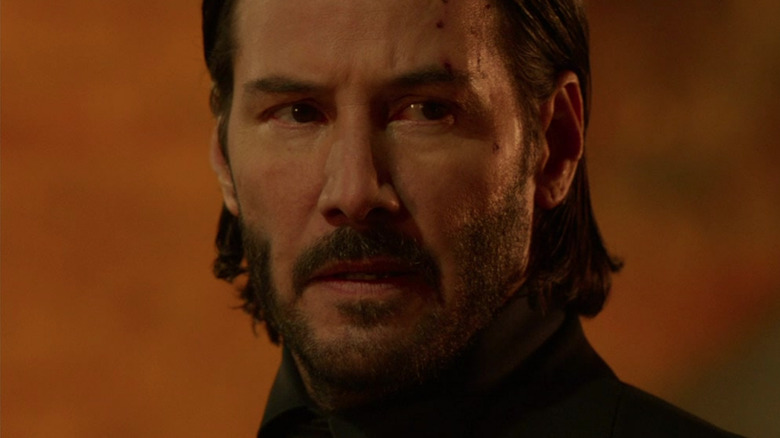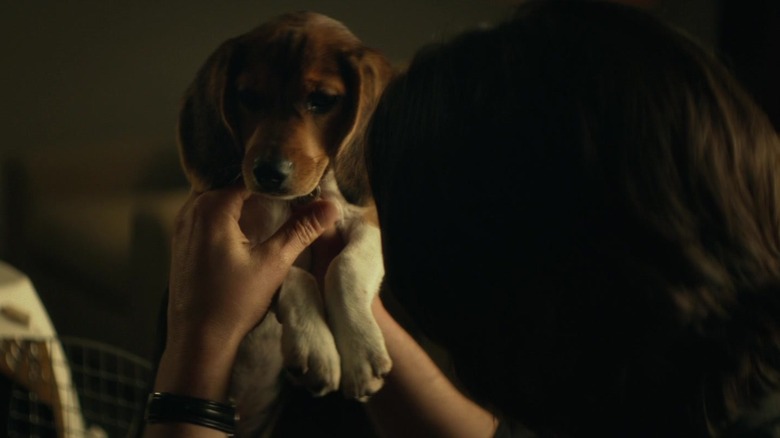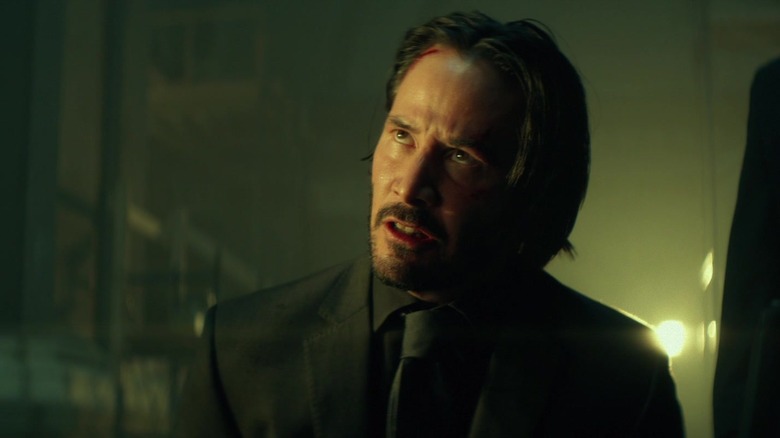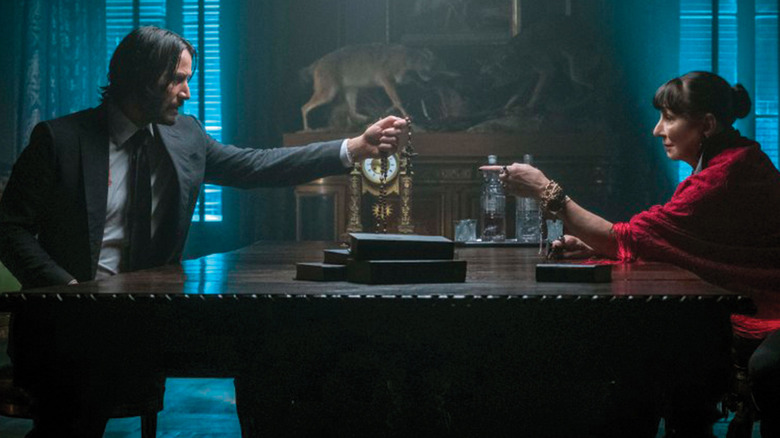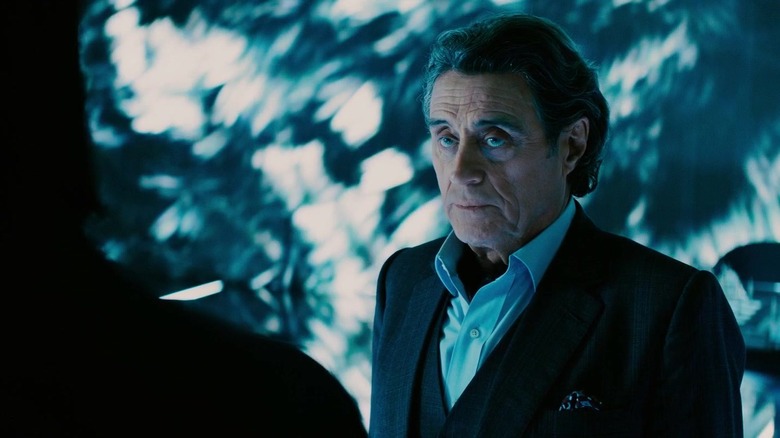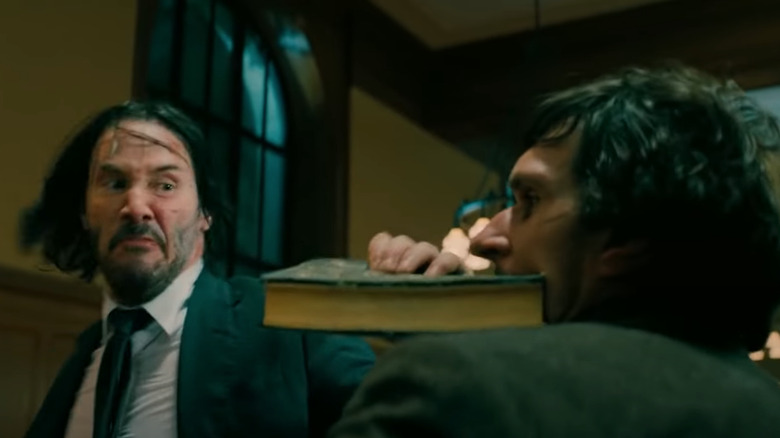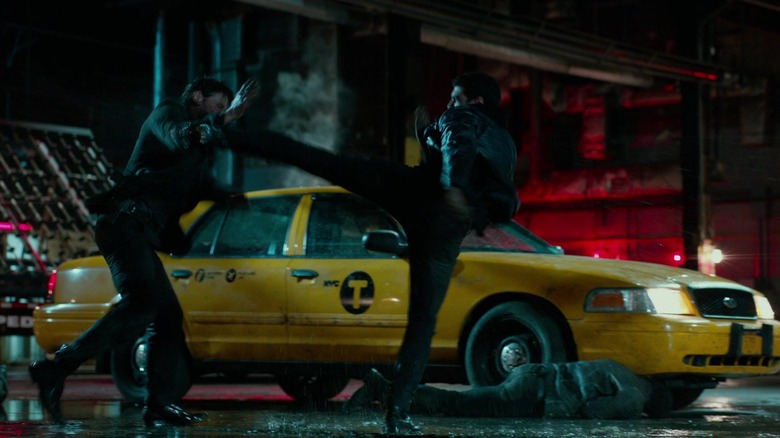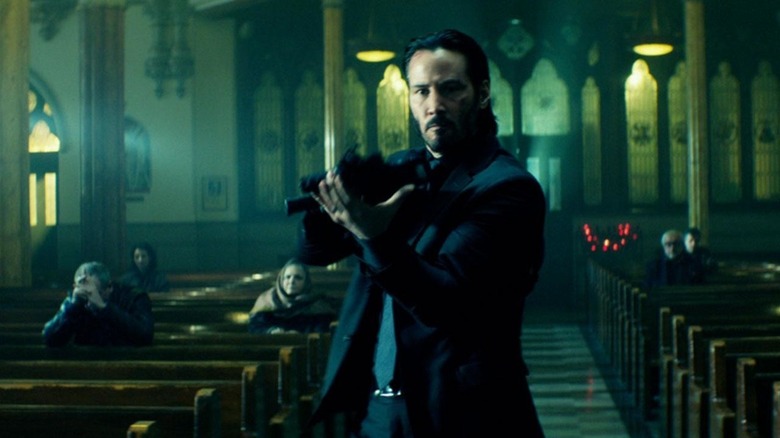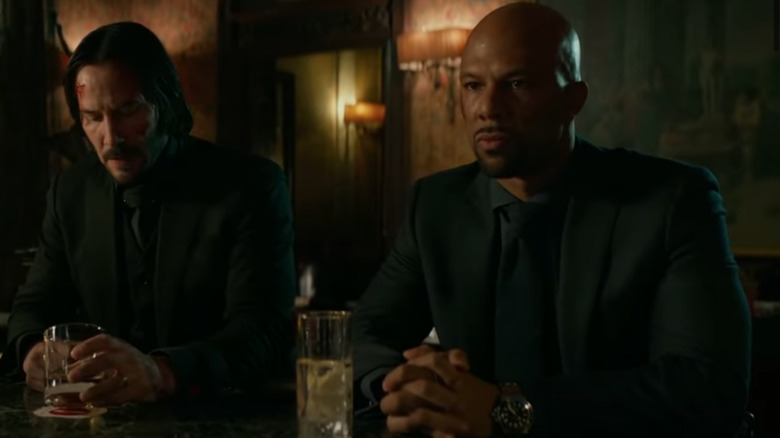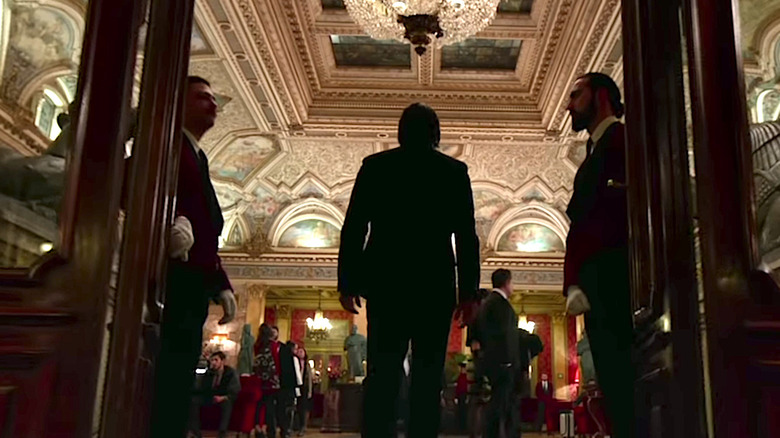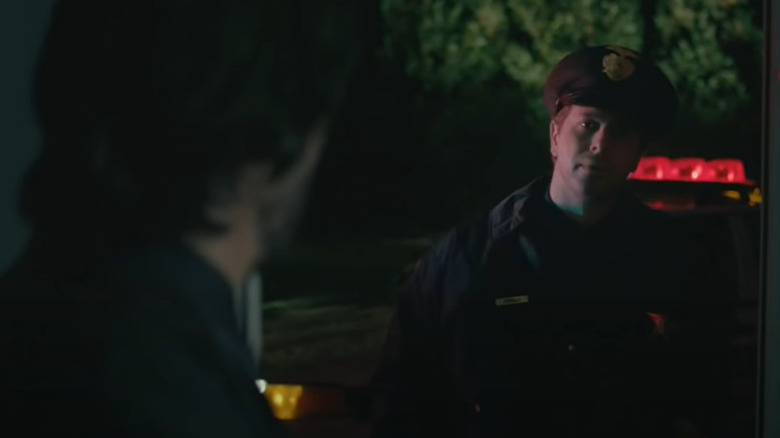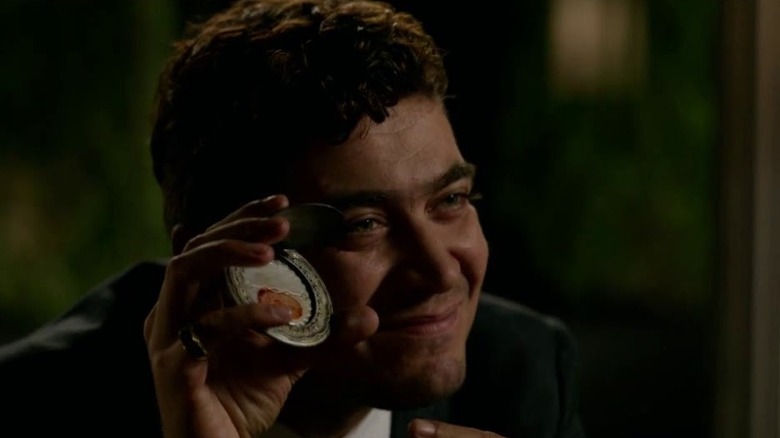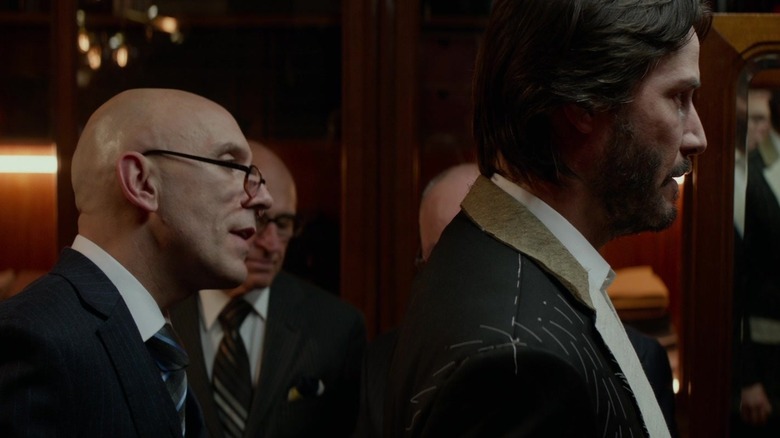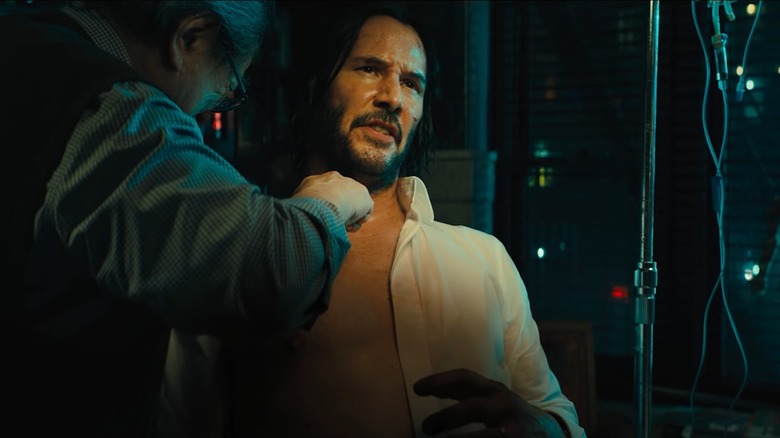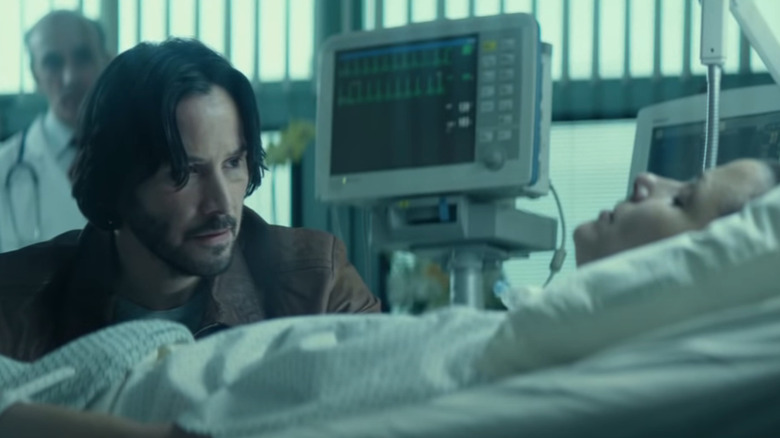Things That Happen In Every John Wick Movie
The action genre was seeing a massive slump in the early 2010s. Thanks to superhero movies, CG spectacle had taken over action scenes to the point where it was impossible to tell what was real and what wasn't. And any action movies that foregrounded practical stunts suffered from massive "shaky-cam" hangovers and choppy editing that made it difficult to track what was going on in a scene.
From this uninspiring creative landscape, there emerged a 2014 action movie starring Keanu Reeves named "John Wick." The plot of the movie is simplistic, but what set it apart upon its release was its action sequences. Long, uninterrupted takes, clear and smooth camerawork, and fluid action choreography showed Reeves as the titular assassin mowing down crowds of enemies using guns, hand-to-hand combat, and any other instrument within reach.
"John Wick" became an instant hit, with audiences and critics lauding the gritty realism and inventive gunplay of the fight scenes. In the next few years, the movie saw the release of two sequels: "John Wick: Chapter 2" in 2017 and "John Wick: Chapter 3 — Parabellum" in 2019, with another "John Wick" on the way next year, a spin-off coming soon (per Collider), and a prequel series in the works (via Deadline). With all this Wick content inbound, let's take a look at some of the story beats you can expect to find in each "John Wick" movie.
John is consumed by vengeance
John Wick (Keanu Reeves) has a painful past. He used to work for the biggest gangsters in the country, killing people left and right and developing a fearsome reputation in the process. But eventually, John tired of his violent life after meeting his soon-to-be-wife. After tying the knot, John retired from the assassin business for good and spent the rest of his days playing with his dog and enjoying retirement, never turning back to his life of violence.
Just kidding. The first "John Wick" movie opens with the main character having recently lost his wife to a terminal illness. All that's left in John's life is his dog, gifted to him by his wife, which is soon killed by Iosef (Alfie Allen), the son of a mob boss (Michael Nyqvist). Thus John embarks on a crusade of vengeance, bringing his artillery out to once again become one of the most dreaded assassins in the world. In the second movie, John crosses paths with another mob boss, Santino D'Antonio (Riccardo Scamarcio).
After Santino attempts to double-cross him, John embarks on a fresh mission of revenge and succeeds in killing Santino by the end of "Chapter 2." But committing this act puts a mark on John's head, and the third movie is all about him becoming a wanted man. The film ends with John once again swearing bloody revenge against anyone who tries to cross him.
John scares everyone all the time
John Wick is often considered one of the most badass anti-heroes ever put to film. The reason for Wick's street cred is that every single person who crosses his path who knows anything about his past is absolutely terrified of him.
The best example of this occurs in one of the most iconic scenes in the franchise, in the first "John Wick" movie. Iosef, the guy who had killed John's dog, does not understand the depth of his mistake. And so his mob boss father patiently explains to him that John is known as "Baba Yaga" in the assassins' world — aka "The man you send to kill the Boogeyman." Basically, John is the guy that other assassins tell horror stories about to one another.
This reputation for being an unstoppable killing machine follows John across every movie, to the point where you are left wondering why anyone would even bother to try to get in John's way without being backed up by a fully locked and loaded army. While this kind of invincibility can get boring after a while, the "John Wick" franchise has managed to make that killer reputation one of its most defining and popular characteristics.
Hints towards a secret world
On the surface, the "John Wick" movies appear to have pretty basic plots. John is wronged in some way, so he goes after his enemies and kills them all in brutal fashions. That's all you need to move the action forward, but the storyline actually goes a lot deeper than that. And it all connects back to John's past as a master assassin working for the mob.
Throughout the trilogy, audiences catch glimpses of a secret world of assassins that operates by its own set of rules. It has its own currency in the form of gold coins, a strict code of conduct for the assassin crowd. And at the heart of it all, the Continental Hotel (actually a chain of hotels) appears to be the place where the people in charge of this world congregate and arrange their missions. The entire criminal network is run by a secret group of powerbrokers: the "High Table."
Fans have long been fascinated by this secret world whose presence is never fully explained or elaborated upon in the movies. Some answers will be provided in the upcoming Continental Hotel spin-off TV series, to focus on the creation of the establishment and its assassin clientele.
Winston helps John
Despite his status as a legendary assassin, John Wick's survival in the movies is hampered by the fact that almost everyone he meets ends up trying to kill him — from the random son of the mob boss who beats John up in the first movie and kills his dog to Santino in the second movie, who first engages John's services and then double-crosses him by putting a price on John's head.
In this sea of enemies, there are very few people whom John can trust to help him even if they are not getting anything in return. Chief among them is Winston (Ian McShane), the manager of the New York Continental Hotel. Winston holds enormous influence in the world of assassins, and he has used that influence on multiple occasions to help John out of respect for their shared past.
In the first movie, Winston allows John to temporarily take cover at his hotel and also provides information about the mob boss John had set out to kill. In the second movie, Winston personally steps in to delay the placing of an "excommunicado" title on John's head, which would have every assassin in the country gunning for him. Then in the third movie, things escalate to the point where Winston teams up with John to go against the High Table and bring down the assassin world's power structure once and for all.
Imaginative murder weapons
The world of "John Wick" is set squarely within a global fraternity of super assassins. And none of the assassins are more super than John Wick himself. As the "Baba Yaga" of the criminal world, John has developed a fearsome reputation as the kind of man who will inevitably kill you once he decides to do so, no matter the obstacles.
Audiences get to see plenty of illustrations of this side of John's character across the trilogy. While he prefers to make use of guns and knives, Mr. Wick is also not above using any hard object that happens to be nearby to give his enemies all sorts of imaginative and brutal deaths. For instance, the first film's mob boss explains to his son in the very first movie that John once single-handedly killed three men in a bar using a pencil. We see this method of murder in action in the second film, where John kills two guys with two pencils. In the third film, when John is faced by a towering opponent in a library, he uses a thick book to break the guy's jaw and shatter his spine. Then there were the horses that John sicced onto his enemies later in the film. Basically, bad guys should feel lucky if John shoots them because the alternative is a lot more drawn out and messy.
Spectacular action sequences
While the "John Wick" franchise has complex world-building and a compelling cast of characters, what put the series on the map was the industry-changing level of sophistication of its action sequences. The franchise was conceived by screenwriter Derek Kolstad alongside David Leitch and Chad Stahelski, two men who had been top stuntmen and second unit directors for years, and you can see the level of expertise they bring to the table as directors.
While other action movies use every trick in the book to hide the fact that the lead actor is not actually doing the stunts themselves, Keanu Reeves trained heavily to be able to do as many of the stunts in-camera as possible. "Stahelski and Leitch were blunt with their star," Matt Patches writes in Grantland. "'John Wick' would not involve kung fu, kickboxing, jump spin hook kicks, wirework, or anything [Reeves had] done before. He would learn judo, Japanese jujitsu, and Brazilian jiu-jitsu from 'some of the toughest guys [Stahelski and Leitch] ever met.'" This allowed for the directors to let complicated fight choreography play out without needing to switch to a double. For his part, Reeves says he does "90%" of the action himself (per Cinemablend). It's no wonder the "John Wick" franchise caused such a revolution in the action movie genre that its style of filmmaking has since been emulated across a variety of movies.
John refuses to forgive and forget
At the start of the "John Wick" franchise, the titular character is living a reasonably inoffensive life. He had retired from his days as a master assassin and only asked to be left alone to grieve the death of his wife with his dog. But fate has other plans, and soon John embarks on a violent quest to avenge the death of his pet.
Once John re-entered the world of assassins and criminal families, there was no going back for him. Time and again, other characters asked, begged, pleaded, or demanded John give up his mission of vengeance and return home. And every time John refused the call, forging forward determinedly to punish those who had destroyed his last chance at anything resembling peace and happiness. "For me, it was fun telling this mythological, Old Testament revenge tale," Keanu Reeves told The Austin Chronicle. "But I don't quite think of it as revenge. I think of it as reclaiming."
John's will to exact vengeance, coupled with his inability to forgive his enemies and go back to his retired life, is the character's defining trait. It is what has led to him almost dying several times. But it is also what makes him such a compelling protagonist whom you cannot help but root for. After all, what's more dangerous and fascinating than a man who no longer has anything left to lose embarking on a do-or-die mission against impossible odds?
A strict code of honor
As an uber-alpha assassin, John Wick is one of the most violent action heroes in modern cinema. He routinely mows down enough enemies to make Rambo blush, yet despite his extremely violent ways, audiences love rooting for the guy. That is because he operates by a strict code of honor among allies and enemies alike. We first glimpse John's code in the first movie, when he offers to let the main villain and his men off the hook if they simply hand over the guy who killed his dog. It's only when the criminals refuse his offer that John goes all Punisher on their butts.
In the second movie, John is unwillingly dragged back into action to honor a pledge he made to another crime boss years ago. In the third film, we see John calling in favors with the gold coins used as currency in the secret assassin world. These coins are the best example of the code that the assassins live by. The coins don't have monetary value, but instead are a token of acknowledgment for services rendered and a debt that will need to be repaid at some point in the future.
His code of honor also determines who he lets live or die — if he respects a fellow assassin enough, even if they're trying to kill him, he might leave them with their injuries rather than finish the job, as when he leaves Cassian (Common) with a knife in his aorta in "John Wick: Chapter 2."
John stops by the Continental
As a man constantly on the run, there are not a lot of places where John Wick can feel safe and at home. One place that keeps popping up in the franchise as a safe haven for even the most desperate individuals is the Continental Hotel, run by John's old friend Winston.
The details surrounding the hotel are wrapped in mystery, but what is clear is that the building is far more than a simple bed-and-breakfast joint. The assassin world revolves around these hotels, and Winston wields enough influence to make sure none of the assassins or mob bosses ever dare get into a fight while on the premises.
In the third movie, Winston plots with John to completely upend the balance of power in the assassin world by taking out the High Table, and the hotel becomes the setting for an epic third-act shootout that ends with John faking his death and Winston being reined in by The Adjudicator (Asia Kate Dillon). It remains to be seen whether the Continental will continue to play an important role moving forward, perhaps by becoming a fortress for Winston, John, and their allies in the upcoming war against the members of the High Table.
Regular people are largely indifferent
The "John Wick" franchise is often praised for being much more gritty and realistic than something like the MCU or the "Fast & Furious" series (per The Guardian). But the truth is the world of "John Wick" is every bit as over-the-top as other major action franchises and filled with events and people behaving in a pretty unrealistic manner.
Case in point, the regular people who surround John Wick who are in no way connected to the criminal underworld. Like the cop who comes to John Wick's house in the first movie, sees corpses in the living room, and goes away without making any further investigations. Or the crowd of people in the second movie milling around John Wick and Cassian, acting completely oblivious to the fact that the two assassins are shooting at each other in plain sight. In the third movie, John Wick engages in a long street chase atop a horse without exciting too much comment from bystanders.
No ordinary civilians seem bothered by the whirlwind of violence that follows John where ever he goes. It's like every noncriminal character in the world of "John Wick" is an NPC player in a video game who only comes alive when the main character has to interact with them in some capacity during their quest.
Many broken promises
John Wick and the rest of the criminal underworld operate by a seemingly strict code of rules. According to these rules, killing each other in the line of business is perfectly acceptable. But breaking a promise is the most despicable sort of behavior, and the reason John is forced to go on so many rampages.
But in a world where promises and oaths are literally the currency, characters are bound to break them all the time. In the first movie, the sanctity of John's retirement (and his promise to take care of one cute little puppy) are shattered, kicking off his journey back into a life of murder to exact bloody revenge. In the second movie, Santino breaks the rules of their agreement and tries to get John assassinated, prompting John in turn to flout the Continental's rules by killing him on hotel property. ("A man can stay here a long time and never eat the same meal twice....")
The third movie visits the consequences of this on John and everyone who helped him. The High Table physically punishes Winston and The Bowery King (Lawrence Fishburne) and then forces them to resign from their positions of authority to atone for helping John Wick. In the meantime, John had made a promise to kill Winston personally, a promise he later walked back on, consequently starting a war with the High Table on one side and John, the Bowery King, and (secretly) Winston on the other.
A snappy suit is essential
On the most surface level, the "John Wick" franchise manages to present the idea that it is a more sophisticated series of action films than something like "Fast & Furious" or "The Expendables" by using a very simple trick. Much like in the "Kingsman" movies, everyone in "John Wick" is almost always dressed in high-end tailored suits.
When we first meet John in the original movie, he is dressed in an unkempt manner, befitting his status as a grieving widow. But once the action starts, John puts on his iconic black tuxedo that manages to conceal a mini army's worth of artillery. The men that John fights in all three movies are also always faultlessly dressed in the most fashionable clothes found in high society despite most of them being hired thugs who kill people for a living.
The fashion of "John Wick" has become its own phenomenon among audiences, with fans wanting to wear the same kind of suits in real life. But the suits worn by Keanu Reeves in the movies are far more complicated than regular business clothing. "There are so many secrets in the suits!" "John Wick" costume designer Luca Mosca tells Gentleman's Journal. "Safety always comes first, so I often had to allow room for pads and anything else Keanu had to wear to protect himself during stunts or fight scenes."
John Wick suffers many injuries
What sets John Wick apart from other action heroes in the genre is the fact that you can clearly see his many violent encounters take a toll on his body. Unlike someone like Vin Diesel's Dominic Toretto, who can shrug off innumerable car crashes across the "Fast & Furious" series and jump out of a speeding car in a muscle shirt without losing both arms, audiences are constantly reminded that John Wick is in very real danger of dying from his brutal injuries.
In the first "John Wick," Keanu Reeves' character suffers a brutal beatdown after being jumped unexpectedly by thugs. After John dons his suit and goes looking for revenge, he's punched, kicked, shot at, and stabbed many times, leaving him bloodied and struggling to stand upright by the end of each movie. He even cuts off a finger in "Parabellum" and later is shot multiple times point-blank and dives backward off a roof.
While John always manages to walk away from his violent encounters in the end, the blood and scars on his face are a grim reminder of the price he has to pay to keep forging his path toward absolution. Those types of injuries help keep the tension high among audiences, as they are left wondering how long John's body can take such heavy abuse without breaking down once and for all.
Memories of past love
At the end of the day, the "John Wick" movies are about violent and remorseless criminals being hunted down by a man who is himself a hardened criminal more violent and remorseless than anyone else in the series. In such a scenario, it could hard to keep rooting for John Wick if the films did not regularly remind us of his loving, nurturing side buried deep within.
The events of the first film are a direct result of the deep love John had for his deceased wife Helen — he just transfers that grief into shooting a lot of bad people. The second movie reveals Bridget Moynahan as Helen in a brief flashback that once again affirms the deep love that John felt for his wife, and how that love made him want to become a better man.
The third movie does not feature any appearances by Helen, but we see John going to retrieve a picture of her in preparation for leaving the country. These moments help solidify the idea that as awful a person as John Wick is forced to be in his dealings with his enemies, he still yearns for the life of companionship he shared with Helen once upon a time. This proof of his love also gives fans hope that John might one day find peace and a quiet life alone, if not a new person to settle down in a loving relationship with.
